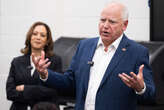As third-generation farmers, my parents were among the first poultry farmers to fight for organic certification standards, and I’ve been a huge supporter of the movement ever since. While I appreciate that organic was—and is—a leaps-and-bounds improvement on conventional agriculture, it missed a critical piece of the better-for-our planet conundrum: long-term, data-centric outcomes. Simply put, organic certification wasn’t designed to measure soil health and therefore doesn’t fully account for the broader farming ecosystem nor its impact on our planet.
A quick drive through California’s Central Valley reveals field after dusty field engulfed in soil that can’t stick to the ground because it’s been robbed of its structure and life. You wouldn’t know from the road which farms are conventional and which are organic; every one of them looks just as depleted, lying beneath the same rust-colored cloud.The heart of the challenge with organic-only farming is that it’s more focused on all the things we don’t do. It’s becoming increasingly clear that simply removing what’s negative from the equation won’t necessarily make it positive. After all, a hole won’t magically fill itself in once you’ve stopped digging.
Take, for example, organic standards for poultry farmers. These standards require that animal feed ingredients are grown without genetically modified organisms (GMOs), synthetic herbicides, pesticides, or fertilizers; that chemicals weren’t used on the farm; that the birds have access to the outdoors; and that they have space to act like, well, birds. It’s a step in the right direction, but clearly it hasn’t been enough to change the landscape of our farms.As the years have piled on, my brother, my husband, and I—who now run our family turkey ranches—knew we were missing a link between our farms, the earth, and products. This was actively discussed at family dinners as we recalled that our grandfather could predict the spring by the richness of almond blossoms. He would pick tomatoes in his garden and reference the soil quality in a growing season. In short, he was connected in a way our generation wasn’t. When we took over the family business several years ago, this became the “aha” moment—our North Star.
Without an emphasis on soil health, our society will continue to run up against economic challenges related to food production—whether it’s organic or conventional—and we’ll continue to face the consequences of food that’s all too often characterized by synthetic inputs, subpar nutrient density, and a negative impact to the land.
But that’s not the road we all have to head down.
Better soil can create better outcomes
That dusty cloud, together with the notable absence of requirements designed to improve environmental outcomes, are among the many reasons the regenerative farming movement has emerged. In a regenerative system, we don’t deplete nutrients from the land as we farm. Instead, we’re focused on putting what’s good back in.
We know that regenerative practices impact soil health and soil matter directly. In a recent comparison of soil health and nutrient density it was found that regenerative farming had up to five times more organic matter and seven times higher soil heath scores. Additionally, a host of studies and peer-reviewed publications have shown the benefits of well-managed grazing practices as a means of improving soil moisture, biodiversity, and carbon sequestration, and reducing erosion, among other things. Already we’ve seen tremendous diversification of grasses grown on our farms from year to year. We’ve gone from two varietals (rye and foxtail) to this past spring finding upward of six different types of grasses (not to mention wildflowers).
Regenerative farming practices are a fundamental shift in farming philosophy. They are finely tuned to the land, location, season, crop or livestock, and other variables specific to each farm, helping to restore soil structure and healthy soil over time. How? With things like rotational grazing, giving pastures time to rest, crop rotation, cover cropping, reduced tilling (or no tilling at all), a diversity of plant and animal species, and so much more.
It’s no surprise that many studies focus on soil organic matter, which is at the heart of this movement and is one of the most neglected (read: most important) factors of productive farming. Soil is a dynamic living ecosystem, extremely complex yet the epicenter of our future.
Scaling the impact beyond organic
Today, roughly 75% of all meat sold in the U.S. is controlled by just five companies. These mega conglomerates have promoted their ways of farming with the justification of “food security,” yet globally 1 billion people are structurally hungry, and our ecosystems are in deep crisis.
At Diestel Family Ranch, our family dinner discussions now revolve around how we can challenge ourselves and industry to think more broadly about our impact as turkey farmers. We continue to incorporate regenerative practices, like planting almost 2 miles of trees, grasses, and flowering shrubs on our farms, which has been a wonderful addition. However, we know our regenerative footprint can be greater, thus we’re connecting with third-party-certified regenerative corn and soy farms to source feed for our birds that is grown with measurable ecological outcomes. But this movement will need greater support from those much larger companies to enact serious changes to our landscape and heal our ecosystems.Don’t get me wrong: I believe wholeheartedly in the promise of organic, and we’ll continue to raise our birds using organic standards. Organic prompted consumers and producers to think more critically about the impact of food production on human health and animal welfare, and regenerative is already doing the same for environmental health.
I buy organic. I’m going to keep buying organic. I hope you will, too. But I’m also going to keep fighting for a new standard—one that puts responsible, innovative land management practices, not just organic practices, at the heart of our food system. One that’s measured and monitored by a qualified, independent third party. One that’s economically viable to scale and has a greater degree of adoption across producers, farmers, and consumers alike.










No comments